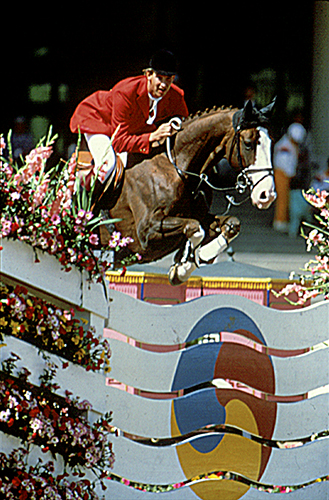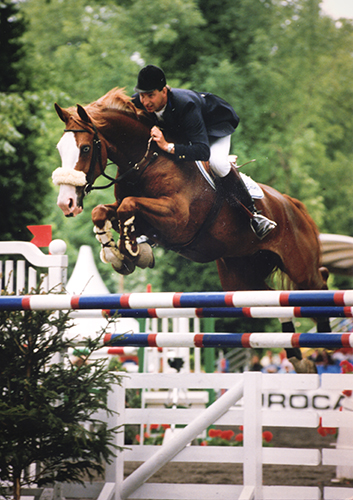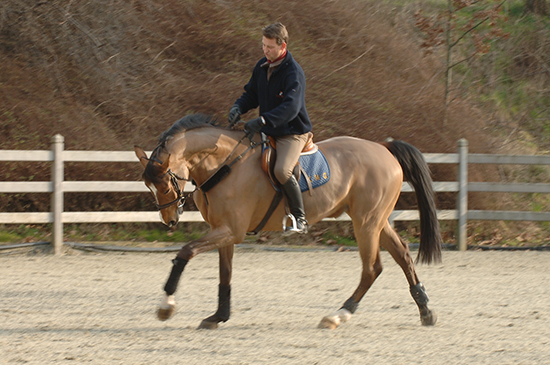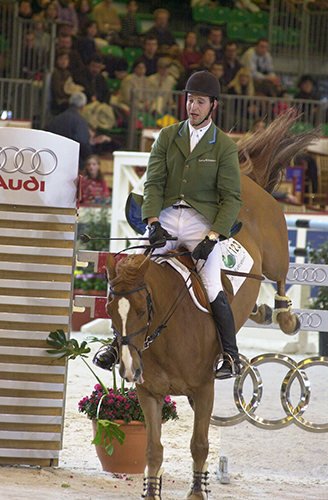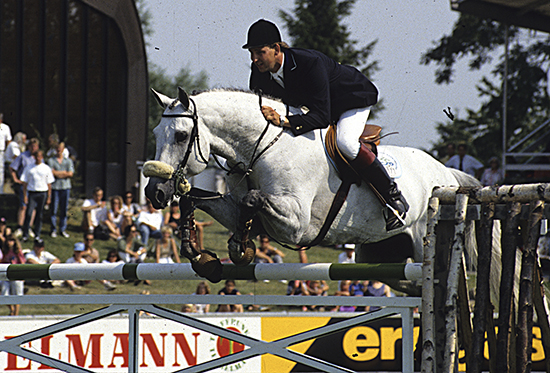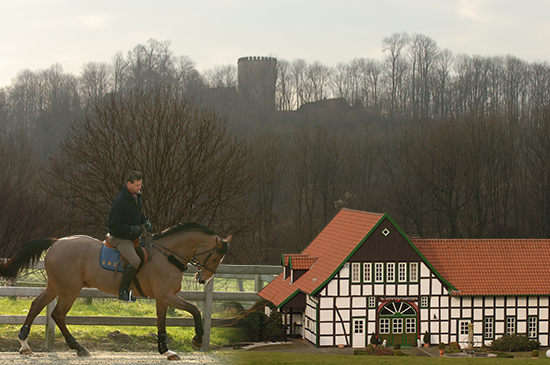 Story by Chris Hector & Photos by Roz Neave and Werner Ernst
Story by Chris Hector & Photos by Roz Neave and Werner Ernst
As we swing through the front gate, we see Franke and his horse, way up in the sky! The outdoor arena has been cut into the hillside, at this most picturesque of training stables. In the foreground, the old traditional black and white stables which now serve as an office, behind that to one side, the beautiful old farm house, and on the other side, state of the art stables and indoor arena.
But today, the weather is good, and Franke and his current number one showjumper Aquino are enjoying the fresh air, and a working session with not one single pole or wing to be seen! Extended trot, collected trot, square halt, extended canter, collected canter, canter pirouettes, and sequence changes – when Franke tells at his clinics how important flatwork is to showjumping success, it is not just for public consumption – he practices what he preaches.
In the German Gold Medal Team at Seoul Games – Franke and Walzerkonig
Born in 1958, Franke has had a stellar career in the sport of showjumping.
Franke competed at four Olympic Games – Los Angeles, Seoul, Barcelona and Atlanta – for two team gold medals and a bronze, he was third at the Rome World Championships, and World Champion at The Hague in 1994.
Currently he is based at picturesque Borgholzhausen, where he continues to produce top class jumping horses.
Strangely, one of Germany’s most successful jumping riders is not German at all…
“I had already been competing for Holland in the Juniors, then I came to Germany because I wanted to learn some more. Alwin Schockemöhle asked me if I would like to work for him, I said, we’ll see, first let’s try for six months. Everything went fine.”
“It was planned that I compete in the Dutch team for Aachen and Rotterdam and in the European Championships, but every time, just a week before, they cancelled, and put someone else in. It was also difficult for me in Germany because Alwin Schockemöhle was the German team chef and for him in his position, to give the Dutch team his horses for me to ride, was not so easy.”
“We talked about it, and he said, in general, it doesn’t matter for which country you are riding for, if you are good enough then you know you have the chance to go anywhere. In 1979 I became a German citizen, and in 1980 I was second in the German Championships. In 81, I was the German champion, in 1984 I competed at the Olympic Games in the German team.”
“For me, our sport is so far individual, that it doesn’t matter for what country you ride. You ride for whoever takes care of you. Everything is up to the individual person. If you and your horse are good enough, you will be part of the team, nobody can stop you. It’s all up to you – you have to look after your owners, your own marketing, your own training, your own preparation. No Federation will help you get to the shows, you need help from individuals – I have my sponsor, my friends, my owners, all these things, but no Federation will help you. This is why every person has the chance to do well. After the WEG in Aachen last year, in Holland they wrote how they have had two world champions, but both for a different country – one for Germany, me in 1994, and now one for Belgium, Jos Lansink, last year.”
For Franke, the time spent with Alwin Schockemöhle instilled in him an awareness of the crucial role of flatwork that drives his training methods even now…
“His strongest part was his flatwork. The dressage, the balance of his horses, was his strength. He also had good sponsors and owners. His timing was fantastic, because there were not so many top riders. He really had that German character – if you wanted to get anywhere, then you had to work – he was so ambitious, and prepared to fight and work for that.”
World Champions – Franke and Weihaiwej
He used draw reins to ride the horses in a very round frame?
“Everybody has a little bit his own style, but even now, the discussion we had last year about the dressage riders who ride their horses so far down – everybody was moaning, but if you looked at the riders who were doing this, they were the top riders in the world.”
“Maybe in his day Alwin Schockemöhle was in front of his time. When you work your horse, it doesn’t matter where the head is, the head can be as low as possible, the important thing is that the wither has to go up. This is where the horse gets his balance, the head is high, the head is low, that’s not the thing, the important thing is the movement of the horse, the activity from behind.”
“Alwin Schockemöhle, he really had his horses from behind, the wither was coming up. In the flatwork, his horses were fantastic movers, lengthening and shortening – all the time in a balance. This was what made Alwin Schockemöhle a top winner, because from his flatwork he got the control and the discipline. And he had good horses.”
Working at home on his current frontliner – Aquino
“What is talent? It is very difficult because it is actually a lot of things together – you can have feeling for the horse, the character, the discipline, the flexibility of your body. Is it your strength? Is it your feeling? So many things but in the end, it is not the rider, the rider is as good as his horses. You can be a super rider with a normal horse, and you have no chance. You can be better than normal people, but you have no chance at the top level. Sometimes we have fantastic horses with average riders, and they have good success – this is possible.”
“It’s like when you train, a bad system is better than no system. It you believe in what you are doing, and every time you do the same things, in the end you will get results. You will have results because the horse will come to you as well. You will end up with a partnership, and this is what we need for the sport.”
After you worked with Alwin Schockemöhle, you worked with Paul Schockemöhle…
“I was eight and a half years with Alwin Schockemöhle then I went to Paul Schockemöhle. It was completely different, because Paul has a big dealing yard. In those days he was really focussed on dealing, and having as well some riders competing for him. It was a bit difficult to make the move because of the family, there was always a little bit of trouble between the brothers. To go from one to the other was impossible, their mother was still alive then.”
“So I went from Alwin’s and said, okay I start out on my own, and I went to a place that was ten kilometres away… nice place, but I got the horses from Paul Schockemöhle to ride. I stayed there half a year, then I went to the place of Paul Schockemöhle – and that’s when I got the chance to go to the Olympics, to Los Angeles with The Farmer.”
“The training there was different, but most of the things I did on my own. Our training did not fit very well together because I’m a natural person, my flatwork and jumping is based on the feeling for the horse. Paul’s opinion was you can train them like a dog, repeat, repeat, and in the end, the horse will learn. But with my way everything went quicker because it was more with a close connection to the horse, to what the horse needed, and the kind of work it needed. I felt what the horse needed, so I approached it in a different way – and made the work shorter.”
“It was the same in a competition, when I said this is a five stride distance, and he said everyone else is doing it in six. I said I know, but for this horse it is five strides, this is my flexibility, to see for each horse what is better. Paul would put everything in the same line.”
“Even now when you walk the course with Paul Schockemöhle, he says, ‘with Diester, I would do this…’ Diester has not been in the sport for ten years, but still when he is walking the course, he is talking about Diester. For me, that is wrong, you have to look for every horse, for every rider, and find what is right for them.”
“Lots of things have changed in the sport. If you look at the pictures of Alwin Schockemöhle riding, it is completely different from how people ride now. My riding was completely different from Alwin Schockemöhle’s riding. A person like Gerd Wiltfang he was in front of his time, he had the balance that even in these days, he would be perfect, because he had the natural talent and the feeling for the horse. For me he was one of the best riders.”
Has your riding changed much over the years?
“No, not so much. You get more experience, you change little things, but in the end, you don’t change so much. You talk with different riders and trainers, and that’s what brings you forward, even when you teach, you notice things – you think, this could be a good exercise for my horse. Then you try it with your horse and see how he reacts, and again you have to be flexible, if the horse doesn’t like this training, then you have try something else. You have to work with your horse, you cannot go against the horse. There are some things the horse has to learn – the basics, the flatwork, the control, this he has to learn, but when you get to Grand Prix competition, then things start to change. At Grand Prix level, very little details have very big effects, there you have to be flexible.”
“To be a trainer for one metre twenty, one metre thirty, that’s quite simple, but when the level goes higher, everything gets much more delicate – and that is where riders have to really learn discipline. You have to ask yourself every day, what am I doing with the horse?”
Was it a big step to leave Paul Schockemöhle and go to ride for the drug rehabilitation community of San Patrignano?
“This was a very big step for me. A positive step. With Paul Schockemöhle I had to ride his horses, even if I didn’t like them. I got them and I had to make the best out of it. He said okay, we have a professional stable, we have to make our living out of it, and I have to give the horses to the riders that fit the horses, and because you are the best rider, you get the worst horses because you make the best out of it. We have to be professional and we have to pick the rider for the horse.”
“At San Patrigano it was different, because I could choose my horses and start to work with them. That made the difference – then you have a completely different objective. I want to be number one, I want to have the best horse.”
The horse that ‘spoiled’ Franke, Joli Coeur at his last World Cup in Bordeaux
Then you set up on your own?
“Vincenzo Muccioli, the founder of San Patrignano died, that was a big change because his two sons who run it now, are not so interested in the horses. They do their show, but they don’t have the interest of the father, who really wanted to be part of the showjumping competition scene. So I made my choice, I have my place here, and I start and try to make it. Maybe later, it will change and I will go just to training and clinics but right now my first aim is to compete. As long as you have the horses, then you compete but sooner or later you come to an age when you have to make a decision – you can’t keep doing this when you are 70.”
You breed a few horses for yourself?
“We have a few for breeding and so far it is looking good. We have some nice foals, some yearlings, some three years old. I have a very nice Baloubet / Landadel, she has been ridden over a few little jumps, now she gets in foal and has the whole summer off, next year we start with her. Breeding is tricky, it costs a lot of money, takes a lot of time, but at the end you still have to wait and see. As a breeder you think, ‘oh my horse looks beautiful’, but you still have to be very lucky for them to succeed in competition. If you look at Paul Schockemöhle, he has been breeding for so many years, 30 years, thousands and thousands of foals, and what comes out is really quite a poor result.”
Franke and the great holsteiner stallion, Corrado at Aachen
Is it getting harder and harder to find those really top horses?
“There’s more money involved. I’ve been competing for thirty years, and it gets harder every year. And one horse is not enough, for a rider to compete internationally, he needs at least three Grand Prix horses. Then you see how hard it is. Then you look at the computer list and you see the names there, say 300 riders, that’s 900 horses! It makes it hard, but it keeps it interesting. If as a top rider you don’t have owners or sponsors, it makes a very hard life.”
“There is not an international Grand Prix rider who can buy his own Grand Prix horse. Even if you take a bag full of money and say, I want to buy a Grand Prix horse, no chance. You can buy a young horse, you can buy a ‘normal’ Grand Prix horse, but not an international horse. If Marcus Ehning went on his own, no sponsors, and tried to buy Kütchengirl, it’s impossible. No chance.”
“Last year if the riders wanted to compete in the circuit Jan Tops organized, then each show they had to pay 10,000 euro – you have the cost of the horse, the cost of the hotel, the grooms, the travel there, your expenses, then before anything starts, you pay another 10,000. Who is able to do this? Who can pay every week, 10,000 euro, and you still have the costs of your stables at home. This is the delicate and dangerous part of the sport. The riders who have lots of money don’t have a problem, but the farmer’s boys, they have no chance any more.”
“The only chance for an Olympic horse is to make one, you cannot go and buy one. That’s what I have to do. I think Aquino has the possibility. We had a few problems last year, but now I think he is on the right direction. I have the feeling and the confidence that he can be ready for the European championships. He is very careful, he’s very rideable – this is the big advantage he has.”
You were saying it was a problem he has such a big stride in the canter that you had to keep shortening him, and he can come too light in your hand?
“This is even more indoors than outdoors, but he has been winning a lot indoors as well, and doing well. But it is delicate, you have to be very sensitive and know what you are doing – or he gets too ‘nice’ in the mouth, but he is jumping well now.”
“I found him not far from here, the first owner had problems with the horse. He was seven years old, but the horse did what he wanted. When the rider before had him, the horse would decide, today we go left, and there was no way the rider could make him go right – next day, the horse says, we go right, and no chance to go left. He has a strong character and in the beginning he had to learn to respect me. Okay in the beginning we had some problems, but in the end it worked out well.”
How soon could you tell how good a jumper this horse was?
“Straight away. This you could see when the horse arrived here, the ability, everything was there, careful, scope, even the rideability was fantastic. The only thing was his mind, if he said, no – it was very difficult. I had a few arguments with him but we got over them. Maybe the problem was when he was young, he won too many times, and then he tried it with me, but he knew in the end there was no chance.”
Today in your working session you just did some trot work, some shoulder in, extensions, canter pirouettes, flying changes, sequence changes, is that a normal working session for him?
“For him the work is just to keep him happy. After the show on the weekend, on Monday, he was out in the paddock, and he loves that! It is so good for the horse’s mind to go out. Every day they go on the walking machine, then in the afternoon sometimes they go for a walk in the woods. His condition is very good, so we just try to keep him happy. Yesterday he worked indoors, and today the weather was good, so I took him outside.”
Will you jump him before he goes to the next competition?
“Some exercises, in and outs… you have to be careful, a lot of people say ‘oh the horse is very good, I’ll leave him in the stable, and he will stay the same’. It doesn’t work. You can’t say that by leaving everything in the package, it will stay the same – with horses you have to continue your work, you have to keep at the jumping exercises. Even if they win the Grand Prix, the next days you have to work out what sort of exercises you need for the next show.”
How many days a week flat, and how many days jumping?
“It depends. When I have a show every ten days, then I don’t do so much at home. But if you have two weeks with no shows, then you have to make something in the middle. For example, if a horse jumps on the Sunday in the Grand Prix, then Monday he is out in the fields, Tuesday and Wednesday, he works on the flat, but he needs some little exercises for his joints and ligaments. It can happen that you have some little injuries, even if you don’t feel them, they will be there – look at a soccer player, the risk is highest after the break for 14 days for Christmas, then they have the first competition, and that’s where they have injuries. Maybe they had those injuries from the last competitions, but normally they have the therapies, the physio and the hard work that gets them over it. It’s the same as if I lay ten days in bed because I am ill, then I start riding again, after three days my muscles really hurt.”
“The horses need work. I don’t like long work, sitting hours on a horse, this is not good. Work for short periods, half an hour, forty minutes, not longer. It is necessary that they walk – they go on the walking machine for an hour, an hour and a half, they have to move. They go on the walking machine every day. But then when you work, half an hour, forty minutes, short but really active. The horse is not made for long periods of work.”
“When they are free, they run for five or ten minutes, then they stop again. They don’t run for an hour. You can only work a horse when it has the feeling it is strong, once the horse feels he is tired, you cannot work him – you can move him, but you cannot work him any more.”
Do you have to work on your own mental preparation, or are you just naturally there?
“Everybody has to work on that. You need horses enough, young horses to work, so you continue to practice every day. You can take time off and you won’t lose the skills, but you lose the ability to be really competitive, that’s why you need to train. You can lose it, you can get careful, you don’t want to make mistakes… and then you are nearly out, you have no chance.”
Do you have a favourite horse – you’ve ridden some pretty amazing ones?
“It doesn’t make sense to compare. When I was a child I had my favourites, I had Rex the Robber, for me that was fantastic. Then I had Argonaut, and won German Champion with him. Farmer, he was not really a winner, but he took me to my first Olympic Games. Every horse had his time, and in his time, you really love the horse and say, okay, this one is the best. They have different qualities. Waltzerkönig, he was a fantastic horse, he was difficult, but he could win. Weiheiwaj, was another fantastic horse, she had some weak parts, we had to change the horse and the work was hard for her, but the end result was fantastic.”
“Jolie Coeur, he was a different horse, he really wanted to fight and do everything for you. In the end my wife said that Jolie Coeur spoiled me – he didn’t like the work at home, he didn’t like the work in the collecting ring, but when you went into the ring, he said, now I am going to fight and do everything for you. That made him special, outstanding. Every horse has a different attitude, that’s why you cannot say which is the best.”
“It’s the time, now, for me, Aquino is the best horse. I have another horse, Legurio, he’s another special horse, so big but so sweet, he tries to do everything right. That gives me the nicest feeling, when the horse is really working for you, that’s the nicest feeling.”
You get the feeling that Franke is one of those people for whom life is filled with the fascination of working with animals – his dogs are highly tuned to his commands, and even the bizarre pair of pigs who wander through the stables, seem vaguely to obey his commands, but in the end it is his fascination with the horse, and the challenge of getting to know the horse, to get the best out of each horse – that’s what makes Franke Sloothaak one of the greats of showjumping.
This article first appeared in THM August 2007.



